
The Neo Geo Pocket Color (NGPC to it’s friends) was SNK’s attempt to revitalise the handheld market in the early 1990s, having recognised that Nintendo’s decade-long dominance of the sector had led to stagnation, and that there was an untapped audience for a more technically advanced system with games that appealed to players who wanted something more than just Pokemon and bad movie licenses. You could (if so inclined) draw parallels between the machine’s short but creatively fertile life and that of the Sega Dreamcast.
Often erroneously described as having been a commercial failure (or having been beaten in the marketplace by Nintendo), the NGPC was in actuality a modest success, thanks to the low price of the hardware, strong marketing and the availability of some recognised franchises (such as Pac-Man, Sonic and Puzzle Bobble). Unfortunately this was too little, too late for SNK.
SNK’s collapse was brought about by serious company-wide issues. The closure of the NGPC business was a result of these issues rather than a significant contributor towards them.
The years that followed the death of the NGPC have seen extremely rapid technological advance in the handheld market (driven by the mass-market adoption of mobile phones) and huge success for new generations of handheld consoles (the Game Boy Advance, Nintendo DS and to a lesser extent the PSP). As a result, NGPC games look and sound a little shabby these days, but the ingenuity, attention to detail and responsive controls that were their hallmarks can still be appreciated.
The machine’s best games included Card Fighters Clash, SNK vs. Capcom The Match of the Millennium, Faselei!, Neo Turf Masters and Sonic Pocket Adventure, all of which are well worth playing (and worth my covering in more detail in future updates). However, the first game I’m going to look at was a lot stranger than any of those. Ganbare Neo Poke-Kun was a virtual pet game and minigame collection that prefigured the WarioWare games, and invites the player to re-examine their definition of what constitutes a ‘game’.
(The following was originally published in March 2003)
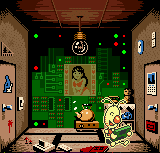
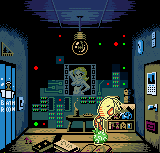
Title: Ganbare Neo Poke-Kun
Developer: SNK
Publisher: SNK
Date Published: 8-6-2000 (Japan)
Platform(s): Neo Geo Pocket Color
Mention the name SNK and the first thing that comes to mind is probably the seemingly endless procession of 2D fighting games that this venerable company produced up until their untimely demise in 2001. (Well, that or Metal Slug.) When it came to providing software for the Neo Geo Pocket Color (their 16-bit challenger to the Game Boy Color), true to form SNK began by cranking out faithful adaptations of their well-known arcade franchises, generally leaving other genres to be addressed by third parties. So it came as something of a surprise when they announced that one of their key titles for Summer 2000 was this… oddity.
Ganbare Neo Poke-Kun (roughly translated, “Do your best, little Neo Geo Pocket man!”) can be (very) loosely categorised as a virtual pet simulation with a collection of thirty-odd (sometimes very odd) minigames hidden inside it.
The main character, the eponymous Neo Poke-Kun, is a little man who lives inside your Neo Geo Pocket Color. (The main scene in the game is a view into his single room apartment in the innards of the machine.) Neo Poke-Kun is a slightly gormless figure with a thin orange body, stick limbs, and a potato-shaped yellow head with antennae and a large orange nose. He likes to sleep and play in his home. The player has no direct control over his actions. However, by manipulating the controls in certain ways they can cause events to occur which affect Neo Poke-Kun and his environment.
The game’s absurdist humour and Gilliamesque visual style are strongly reminiscent of a game for the Mega CD (and later Playstation 2) called Switch.
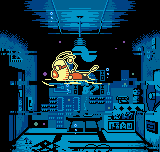

Home Sweet Home
Neo Poke-Kun’s room has little in the way of furniture but is packed with tiny details. The left wall is taken up by the bathroom door. The right wall is taken up by the front door. Towards the rear of the room is a small tea table and a side cabinet with a phone. The back wall is in semi-darkness, and there are flashing lights, electronic components and a girlie poster visible on it. The floor (where Neo Poke-Kun sleeps) is strewn with (at different times) books, magazines, videos, and a games console. A large, bare lightbulb hangs from the ceiling. The time within the game world is linked to the internal clock in the NGPC, changing the appearance of the room (and altering other aspects of the game) depending on whether it’s morning, evening or night.
The virtual pet aspect of the game allows the player perhaps the most indirect and limited range of controls ever seen since Dragon’s Lair. Tilting the thumbstick in different directions causes small things to happen in Neo Poke-Kun’s room that seem to have no obvious effect on him (such as turning the light on and off, or makes a beckoning hand/foot poke through the letterbox on the front door) Spinning the thumbstick rapidly will cause an accident (or worse, a disaster) to befall Neo Poke-Kun. These can range from things falling on him (including a goose embedding it’s beak in his head), to the bathroom flooding, a hole opening in the ground and swallowing him, or even the room being burnt down or destroyed in an earthquake. After the calamity has passed, Neo Poke-Kun and his room will be restored to normal but Neo Poke-Kun will be emotionally affected.
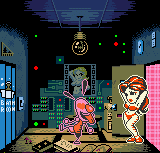

Ding-Dong…
Pressing the ‘A’ button causes the doorbell to ring, signaling the arrival of a visitor. Most of the time spent observing Neo Poke-Kun is taken up with summoning visitors and watching what they do. Each visitor’s actions have a specific effect on Neo Poke-Kun (making him happy, angry, confused, scared, or embarrassed). There are many, many visitors who can drop in on Neo Poke-Kun and most of them can interact with him in a number of ways. Usually they enter the room, do something and leave (through the front door or the bathroom door). Some cause so much chaos that the video feed cuts to static for a second and when it comes back things have returned to normal. These are some of the more notable ones:

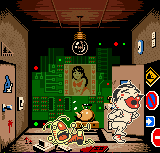
Sideshow pervert: One of the most versatile characters is this rather effeminate Japanese man dressed in a posing pouch. He runs into the room and gestures excitedly for Neo Poke-Kun to do something, for instance tie the ends of his absurdly long moustache together. He will then perform a (often distressingly biological) trick, in this instance (the tamest), skipping with his moustache. His greatest achievement that I have witnessed so far could be called ‘the human party popper’. (Don’t ask.)
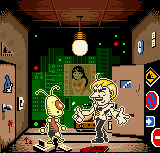
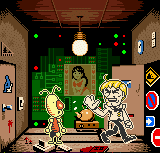
Pep talk man: A man in a suit who approaches Neo Poke-Kun and slaps his cheeks with both hands in a rousing, ‘hang in there, son’ fashion. Sometimes he pats Neo Poke-Kun’s crotch instead, or some combination of the two, before leaving with a smile and a wave.
Space Hero: A space adventurer who leaps into the room, performs a heroic pose and then flies out of the room. Neo Poke-Kun is delighted by this.
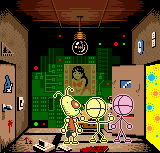

Stick man: One of the most annoying characters, a featureless yellow stick man who enters the room, and draws a pattern in the air which causes Neo Poke-Kun to become frozen. Sometimes he enters the room with a friend (the pink stick man), and teaches his friend how to draw the pattern.
Old man: An old man with an IV drip stand. He causes Neo Poke-Kun to go into a trance. When Neo Poke-Kun gets close to him he flies into a rage. Sometimes he enters the room and dies, and his ghost floats out of his body. When Neo Poke-Kun approaches his body, the ghost jumps back in and the old man gets up and flies into a rage again.
Bat: A large bat enters the room while Neo Poke-Kun is asleep, flies around for a bit then hangs from the lightbulb and makes a loud, bizarre noise which wakes Neo Poke-Kun up and makes him angry.
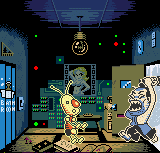

There are many, many others (the rabbit, the disgusting dog, the giant nose, the bikini lady, the spy, the tornado, the crocodile, the turtle, the caveman, the drag racer…) with more becoming unlocked as the game progresses.
Ringing the doorbell too frequently can cause the door to break, temporarily preventing the player from summoning visitors. Sometimes the door becomes fitted with a large megaphone, and pressing ‘A’ causes different sounds to be played (including an extract from Beethoven’s Fifth, a pneumatic drill, a cat, and many more, all of which have a different effect on our hero). These events are designed to put the player into a ‘time-out’ from calling new visitors, instead turning the player’s attention to either playing minigames or causing accidents.
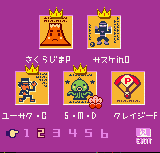

Minigames
There is another side to the game quite apart from interacting with and observing Neo Poke-Kun. You see, Neo Poke-Kun is in fact a programmer. If the player consciously tries to keep Neo Poke-Kun happy, Neo Poke-Kun will in turn be more willing to go to work on programming minigames for their entertainment. Pressing ‘B’ while Neo Poke-Kun is idle will replace his lightbulb with a flashing siren, compelling him to run towards the front of the room. The minigame menu will then be presented.
From this menu the player can chose to play any minigame that Neo Poke-Kun has finished developing, and inspect the progress of each game in the pipeline (given as a percentage). Cancelling the minigame menu returns to Neo Poke-Kun’s room (and, if he’s in a good enough mood, prompts Neo Poke-Kun to pick up his tools and leave for work).
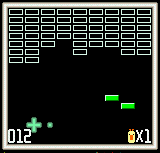
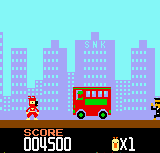
The minigames are divided into six generations of five games each. Each generation is more technically complex than the last: the first generation are based around Pong and Breakout, the second includes parodies of Shinobi and Galaga, while the third introduces some games with wireframe 3D elements. If the player can achieve a high enough score or last a certain number of rounds in a given minigame, they get a congratulatory message and an award (denoted with a crown, with exceptional performances getting a plum, bamboo, or pine medal).
It is unclear whether awards translate to any differences in Neo Poke-Kun’s behaviour or environment, but it seems that the number of games successfully completed limits the number of new games that can be unlocked at any given time.
Regardless of how well the player treats Neo Poke-Kun, the rate at which new games can be unlocked is effectively time-limited. Sometimes the game will only throw up negative visitors and/or Neo Poke-Kun will be unreceptive to positive events, steadfastly preferring to sleep rather than going to work.
(As luck would have it, PC versions of three of the minigames have been archived from SNK’s now-defunct website, and can be downloaded here.)


Ganbare Neo Poke-Kun obviously can’t be judged against games with more conventional styles of gameplay. The minigames vary in quality: some are simplistic and frustrating, with unresponsive controls, while a few seem to have had a lot more effort put into them and are reasonably addictive.
Interacting with Neo Poke-Kun manages to hold the player’s interest by the sheer number of possible events and animations that can be triggered (the game’s determination to flout logic and convention ensures that each new element is a surprise), although the minimal interaction and occasional bouts of repetitiveness mean that this side of the game can’t really be played for extended sessions.
The game has minimal Japanese text (one-screen descriptions of each minigame, and occasionally large dialogue boxes with extracts from the credits fly through Neo Poke-Kun’s room). It is equally inexplicable in any language. You should be able to track down a copy through importers or eBay. Failing that, Neo Geo Pocket Colour emulators have reached the stage where they can run the game acceptably well (although I’ve been unable to test all the later minigames yet).
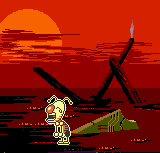
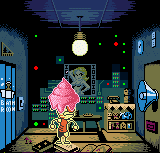
Tags: Game, game title, ganbare neo-poke kun, lookback, minigames, neo geo pocket colour, ngpc, virtual pet
